Kwidzyn
Kwidzyn (pronounced Kfee-dzin [ˈkfʲid͡zɨn]; Latin: Quedin; German: Marienwerder; Old Prussian: Kwēdina) is a town in northern Poland on the Liwa River, with 38,553 inhabitants (2018).[1] It has been a part of the Pomeranian Voivodeship since 1999, and was previously in the Elbląg Voivodeship (1975–1998). It is the capital of Kwidzyn County.
Kwidzyn | |
|---|---|
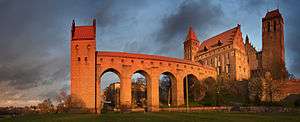  .jpg)   Photos of Kwidzyn | |
 Flag 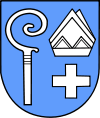 Coat of arms | |
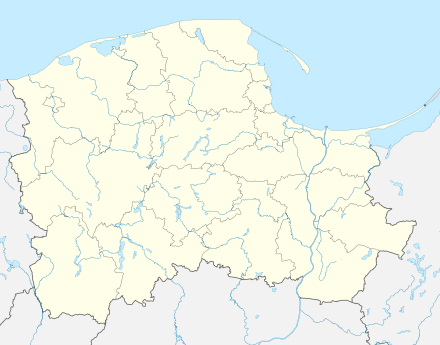 Kwidzyn  Kwidzyn | |
| Coordinates: 53°44′9″N 18°55′51″E | |
| Country | |
| Voivodeship | |
| County | Kwidzyn County |
| Gmina | Kwidzyn (urban gmina) |
| Established | 11th century |
| Town rights | 1233 |
| Government | |
| • Mayor | Andrzej Krzysztof Krzysztofiak |
| Area | |
| • Total | 21.82 km2 (8.42 sq mi) |
| Elevation | 42 m (138 ft) |
| Population (2018) | |
| • Total | 38,553[1] |
| Time zone | UTC+1 (CET) |
| • Summer (DST) | UTC+2 (CEST) |
| Postal code | 82-500 |
| Area code(s) | +48 55 |
| Car plates | GKW |
| Website | http://www.kwidzyn.pl |
History
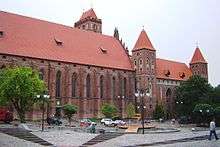
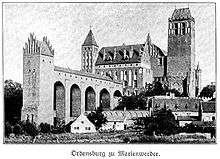
The Pomesanian settlement called Kwedis existed in the 11th century. In 1233, the Teutonic Knights built the Burg Marienwerder and established the town of Marienwerder (now Kwidzyn) the following year. In 1243, the Bishopric of Pomesania received both the town and castle from the Teutonic Order as fiefs, and the settlement became the seat of the Bishops of Pomesania within Prussia.[2] The town was populated by artisans and traders, originating from towns in the northern parts of the German empire. A Teutonic knight, Werner von Orseln, was murdered in Marienburg (Malbork) in 1330. He was among the first to be buried in the newly erected cathedral of the town.
St. Dorothea of Montau lived in Marienwerder from 1391 until her death in 1394; future pilgrims visiting her shrine would contribute to the flourishing economy.
The Prussian Confederation was founded in the town on March 14, 1440.[3] After the defeat of the Teutonic Knights in the Thirteen Years' War, the western part of their monastic state of the Teutonic Knights would be annexed by the Kingdom of Poland and would form the Polish province of Royal Prussia. The remainder, known as Teutonic Prussia, to which Marienwerder belonged, was placed under Polish suzerainty as a fief. In 1525, the Teutonic state was transformed into a secular and Lutheran duchy under the last Grand Master of the Teutonic Order Albert, a political foundation only possible with the consent of the Polish King Sigismund I the Old. In 1618 the ducal rights were inherited by the Brandenburg branch of the House of Hohenzollern and in 1657 the Brandenburg dukes severed ties with the Polish crown and in 1701 elevated their realm to the sovereign Kingdom of Prussia.
The town of Marienwerder meanwhile had become the capital of the District of Marienwerder. In 1772 the Marienwerder district was integrated into the newly established Prussian Province of West Prussia, which consisted mostly of territories annexed in the First Partition of Poland.
By the enlargement of its administrative functions, the population of the town started to grow and in 1885, it numbered 8,079. This population was mostly composed of Lutheran inhabitants, many of whom were engaged in trades connected with the manufacturing of sugar, vinegar and brewing as well as dairy farming, fruit growing and the industrial construction of machines.
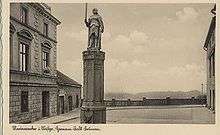
As a result of the Treaty of Versailles after World War I, the Marienwerder district was divided. The parts west of the Vistula were incorporated into the Polish Second Republic. The parts east of the Vistula, to which the town of Marienwerder belonged, took part in the East Prussian plebiscite which was organized under the control of the League of Nations. In Marienwerder 7,811 votes were given to remain in East Prussia, and therefore Germany, and 362 for Poland.[4]
On November 10, 1937, when the Nazi regime was in power in Germany, a Polish private high school was opened. It was forcibly closed down on August 25, 1939.[5]
On January 30, 1945 during World War II, the town was captured by the Soviet Red Army. The Red Army established a war hospital in the town for 20,000 people. The town centre was burned and pillaged by Soviet soldiers.
After World War II, the region was placed under Polish administration by the Potsdam Agreement, under territorial changes demanded by the Soviet Union. Most of the people of the town and district were Germans who fled or were expelled by Polish authorities, and were to be replaced with Poles, some of whom had themselves been expelled from the Polish areas annexed by the Soviet Union. In 1947, Ukrainians from the Soviet border regions were forced to settle in the area as a result of Operation Vistula.
Geography
Kwidzyn is located on the east bank of the Vistula river, approximately 70 kilometres (43 miles) south of Gdańsk and 145 kilometres (90 miles) southwest of Kaliningrad.
| Year | Inhabitants |
|---|---|
| 1400 | approx. 700 |
| 1572 | approx. 700 |
| 1782 | 3,156 |
| 1783 | 3,297 |
| 1831 | 5,060 |
| 1875 | 7,580 |
| 1880 | 8,238 |
| 1890 | 8,552 |
| 1900 | 9,686 |
| 1905 | 11,819 |
| 1925 | 13,721 |
| 1930 | 13,860 |
| 1933 | 15,548 |
| 1939 | 19,723 |
| 1965 | approx. 13,000 |
| 2006 | 37,814 |
| The above table is based on biased primary sources from the time of Prussian Partition of Poland.[2][6][7][8][9] | |
Points of interest
The Kwidzyn Castle is a partially ruined 14th century Brick Gothic Ordensburg castle of the Teutonic Order, namely the Bishops of Pomesania. A large cathedral built between 1343 and 1384 is connected to the castle. It contains the tombs of three Grand Masters of the Teutonic Knights as well as numerous bishops. A bridge connects the castle to a sewer tower. This tower used to be by a river which has since changed its course, leaving the tower on dry land.
Kwidzyn has a Catholic church and a cathedral castle presently used for the museum of Lower Powiśle.
Other sights include the appellate court for Kwidzyn County, a town hall, and government buildings.
Economy
A branch of International Paper is located in Kwidzyn, as is the Kwidzyn School of Management.
The second biggest employer in Kwidzyn is Jabil, a global electronics manufacturing services company.[10]
The city has lower average crime and unemployment rates when compared to the national average rates of Poland.[10] These lower rates are attributed to sports programs for youth such as MMTS Kwidzyn (handball) and MTS Basket Kwidzyn.[10]
Notable people
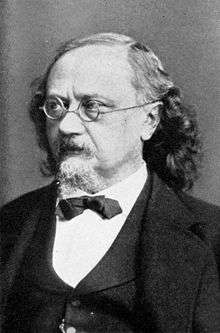
- Dorothea of Montau (1347–1394), hermitess and visionary of 14th century Germany, canonized in 1976.
- Paul Speratus (1484–1551 in Marienwerder), Catholic priest who became a Protestant preacher, reformer and hymn-writer
- Eduard Heinrich von Flottwell (1786–1865), Prussian Staatsminister and Regierungspräsident of Marienwerder in 1825
- Hans Adolf Erdmann von Auerswald (1792–1848), Prussian general and politician
- Karl Ludwig Hencke (1793–1866 in Marienwerder), amateur astronomer and discoverer of minor planets
- Rudolf von Auerswald (1795–1866), Prime Minister of Prussia
- Carl Julius Meyer von Klinggräff (1809–1879), German botanist
- Hermann von Dechend (1814–1890), first President of the Reichsbank
- Heinrich Julian Schmidt (1818–1886), German journalist and historian of literature [11]
- Rudolf Heidenhain (1834–1897), German physiologist
- Gustav Cohn (1840–1919), German economist, particularly re. public finance
- Elard von Oldenburg-Januschau (1855-1937 in Marienwerder), German Junker and conservative politician.
- Kurt Rosenfeld (1877–1943), lawyer and politician
- Józef Krasnowolski (1879–1939), Polish painter
- Fritz Goerdeler (1886–1945), German jurist and resistance fighter; mayor 1920-33
- Joachim Witthöft (1887–1966), general
- Kurt-Jürgen Freiherr von Lützow (1892–1961), general
- Ida Siekmann (1902–1961) nurse, first victim of Berlin Wall
- Ernst Schiffner (1903–1980), German actor and director
- Ernst Tillich (1910–1985), German theologian
- Bernard Friese (1927–2010), co-founder of Gilbern cars
- Hardy Rodenstock (born 1941), music publisher and manager; dealer in old and rare wine
- Wiesław Hartman (born 1950), Polish show jumping equestrian, silver medallist in the 1980 Summer Olympics
- Wojciech Belon (1952–1985), Polish poet, songwriter and folksinger
- Izabela Tomaszewska (1955–2010), Polish government official and archeologist
- Tomasz Piotr Nowak (born 1956), Polish politician
- Jacek Borcuch (born 1970), Polish actor and film director
- Marek Szulen (born 1975), Polish composer of electronic music, lives in the Netherlands
- Maciej Silski (born 1976), Polish singer
Burials
- Werner von Orseln (c.1280–1330) the 17th Grand Master of the Teutonic Order
- Otto Friedrich von der Groeben (1657–1728) a Prussian explorer, officer and German Generalleutnant in Polish service
Gallery
 Kwidzyn Cathedral
Kwidzyn Cathedral_ID_636613.jpg) District court
District court Town Hall
Town Hall_ID_636564.jpg) Post office
Post office Powiślańska Szkoła Wyższa (Powiśle College)
Powiślańska Szkoła Wyższa (Powiśle College) Saint Padre Pio chapel
Saint Padre Pio chapel Holy Trinity church
Holy Trinity church- Library and a monument of Józef Piłsudski
 Train station
Train station Former Saint George hospital
Former Saint George hospital Vocational school
Vocational school Former casino and cinema building
Former casino and cinema building
International relations
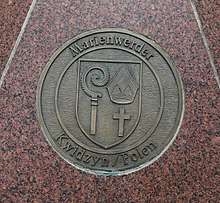
Kwidzyn is twinned with:
|
References
- "Kwidzyn (pomorskie) » mapy, nieruchomości, GUS, noclegi, szkoły, regon, atrakcje, kody pocztowe, bezrobocie, wynagrodzenie, zarobki, edukacja, tabele, demografia, przedszkola". Polska w liczbach.
- August Eduard Preuß: Preußische Landes- und Volkskunde. Königsberg 1835, pp. 441–444.
- Jürgen Sarnowsky: Der Deutsche Orden. Beck, Munich 2007, ISBN 978-3-406-53628-1, p. 100 ff. (restricted preview).
- Marzian, Herbert; Kenez, Csaba (1970). Selbstbestimmung für Ostdeutschland – Eine Dokumentation zum 50 Jahrestag der ost- und westpreussischen Volksabstimmung am 11. Juli 1920 (in German). p. 117.
- Andreas Lawaty, Wiesław Mincer and Anna Domańska: Deutsch-polnische Beziehungen in Geschichte und Gegenwart – Bibliographie. Vol 2: Religion, Buch, Presse, Wissenschaft, Bildung, Philosophie, Harrassowitz, Wiesbaden, ISBN 3-447-04243-5, p. 879 (restricted preview)
- Michael Rademacher: Deutsche Verwaltungsgeschichte Provinz Westpreußen, Kreis Marienwerder (2006)
- Der Große Brockhaus, 15th edition, Vol. 12, Leipzig 1932, p. 143.
- Meyers Großes Konversations-Lexikon, 6th edition, Vol. 13, Leipzig and Vienna 1908, p. 299.
- Johann Friedrich Goldbeck: Vollständige Topographie des Königreichs Preußen. Teil II, Marienwerder 1789, pp. 3–6.
- Turystyka, historia, zabytki. Kwidzyn Moje miasto.
- . Encyclopædia Britannica. 24 (11th ed.). 1911.
- "Stadt Celle". www.celle.de. Retrieved 2010-01-05.
Sources
- Stephen Turnbull: Crusader Castles of the Teutonic Knights: The Red-Brick Castles of Prussia 1230-1466, October 2003 (eBook, PDF)
External links
| Wikimedia Commons has media related to Kwidzyn. |
- Municipal website (in Polish)
- Kwidzyn School of Management
- Kwidzyn City Portal (in English)

